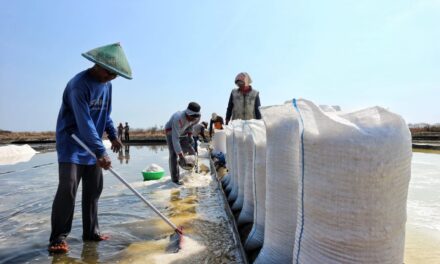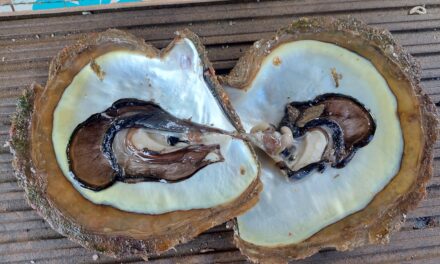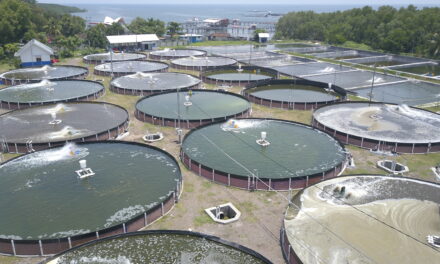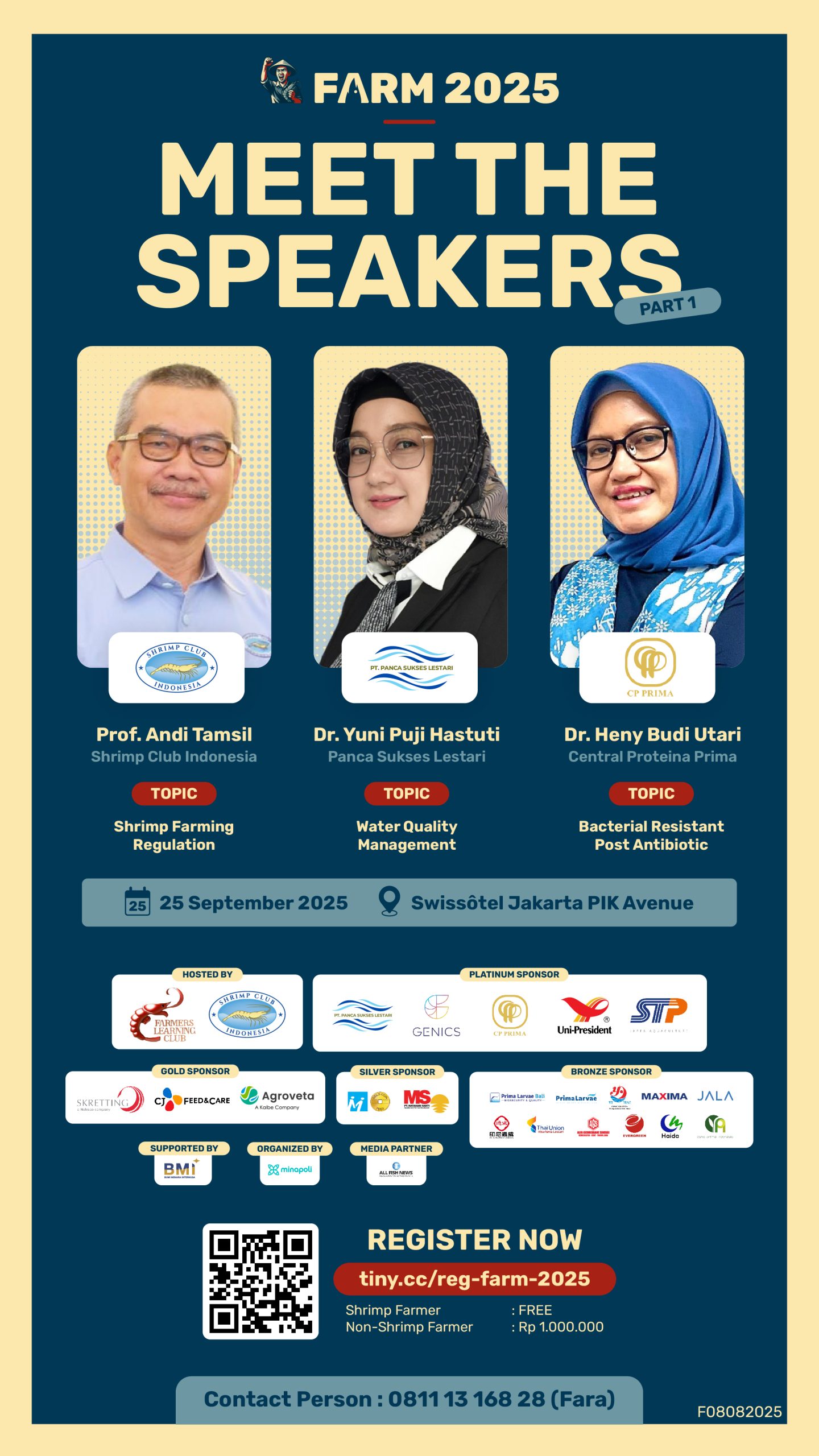By 2050, the world’s population is projected to reach 10 billion, triggering a 56% surge in global food demand. This naturally requires the exploration of new agricultural lands to boost productivity. Ironically, the agricultural land area in Indonesia has been shrinking annually, resulting in stagnant production yields. In response, blue food is being considered as a potential solution to address future global food security challenges.
Blue food is defined as a variety of food derived from aquatic resources like fish, crustaceans, mollusks, seaweed, and other aquatic organisms, whether obtained through capture or aquaculture. This concept has surfaced as part of a broader movement advocating for sustainable food resources. Blue food has been gaining significant attention, not just for its potential as a highly nutritious food source but also for being relatively more environmentally friendly when compared to certain land-based sources.
Acknowledging the considerable potential of blue food, the Indonesian National Development Planning Agency (Bappenas) recently organized the Blue Food Forum with the theme “Strengthening Collaboration on Blue Food Program” in Lombok. The event brought together a diverse group of stakeholders, including academics, entrepreneurs, and government officials in the marine and fisheries sector. The aim was to engage in discussions about their respective contributions to sustainable maritime and fisheries sector.
Seaweed industrialization
According to M. Firman Hidayat, the representative of the Coordinating Ministry for Maritime and Investment Affairs (Kemenko Marves), one of the key commodities in the development of blue food is seaweed. Known for its rich nutrients and ease of cultivation, seaweed provides numerous health benefits. These include reducing obesity and cardiovascular diseases, controlling blood sugar, and being a rich source of vitamins, minerals, and fiber.
Additionally, from a farming perspective, seaweed can serve as a strategy for climate change mitigation. Compared to land-based commodities, seaweed requires minimal land and emits the least carbon while maintaining high productivity. On the flip side, seaweed naturally absorbs more carbon than it releases. Firman predicts that this advantage will significantly boost the demand for seaweed, potentially increasing it twelvefold.
Read more: Five key focus areas in Indonesia’s blue economy strategy
Meanwhile, from an economic perspective, the upstream-downstream of the seaweed industry holds significant potential to enhance the well-being of farmers. Currently, there are around 63,000 households engaged in seaweed farming, with the majority having only elementary education. Only about 6% of them have access to banking services. “If we can address the issues related to seaweed, then we should be able to improve the farmers’ well-being,” stated M. Firman.
Promoting the implementation of blue food is aligned with Indonesia’s vision for 2045, aiming to achieve a higher and more equitable level of well-being for the Indonesian people with enhanced human quality. However, to reach this target, Indonesia must attain an economic growth rate of 6-7%, where the maritime sector can play a significant role in fostering the national GDP.
“One of the primary issues that needs improvement in the maritime sector is the industrialization of fisheries processing, as its share is still relatively small at around 4.13%, compared to other types of fisheries industries. Yet, the downstreaming potential in the maritime and fisheries sector is just as significant as in the mining sector,” explained Firman.
Thedownstreaming potential extends to commodities like seaweed, serving as a valuable raw material for both the food and non-food industries, including bioplastics, biostimulants, and pharmaceuticals. The demand for seaweed is on a rising trend. According to him, “The market for seaweed derivative products is enormous. For example, the potential market for biostimulants is USD1,800 billion, and USD733 billion for bioplastics. This information is from a report by Standard Chartered Bank.”

Seaweed has the potential to enter various industries if its price can be reduced through an increase in the scale of cultivation. ©Yotube/BappenasRI
However, he said that the primary key to advancing the seaweed industry is to boost productivity by expanding cultivation areas. This approach allows significant production of raw materials to fulfill the requirements of various downstream industries.
The expected increase in productivity is set to make seaweed more affordable, making it a viable option for various industries. With the current price ranging from USD1,000-2,000 per ton, seaweed is economically feasible only for a few industries like pharmaceuticals, health, food additives, and biostimulants. However, the price would need to be considerably lower for some others including alternative noodle products, bioplastics, as well as biofuels.
The Coordinating Ministry for Maritime and Investment Affairs has suggested a calculation regarding the price of seaweed as a raw material for certain industries. If seaweed is considered an alternative to wheat-based noodles, plastics, and fossil fuels, the price should be reduced to USD 100-300 per ton. Increasing the supply volume can compensate for this price reduction, tapping into the potential of a significantly larger market.
The cost of seaweed as a raw material is often less economical for industries because of its limited supply, stemming from traditional cultivation on a small scale. This traditional approach requires a significant amount of labor and lacks efficiency. Therefore, there is a need for mechanization and the technology application to boost productivity. “If we can increase productivity, the costs will automatically decrease,” said Firman.
Read more: Revitalizing Indonesia’s maritime strategy: Harnessing Blue Economy for inclusive growth
In terms of industrialization prospects, Firman mentioned that a company is gearing up to initiate an integrated pilot project for seaweed cultivation in Lombok, spanning from upstream to downstream stages. The anticipated outcome of this project is a significant increase in productivity by 9-10 times.
The challenges of seaweed-based blue food
Developing the seaweed industry comes with various challenges, and a significant one is the necessity for expanding cultivation areas. According to Firman, his office Kemenko Marves aims to increase the farm area from the current approximately 102.000 hectares to 1 million hectares which needs policy support such as from the Suitability of Marine Space Use (KKPRL).

The Indonesian government aims to increase seaweed cultivation area from 102 thousand hectares to 1 million hectares. ©KKP RI
He also highlighted the importance of establishing clear zones between traditional farmers and big farm companies. Farm companies ideally should be situated offshore, while small-scale farms can operate onshore near the coast. Moreover, the challenge of ensuring good seed availability requires collaboration from both the private sector and local government.
Meanwhile, Sudari Prawiro, a representative from UNIDO, suggested that the government should establish product standardization for aquatic products, including seaweed, to facilitate industry adherence to processing standards. The lack of distinct categorization between seaweed and other seafood in certifications has restricted producers in the downstream sector from exporting their products, particularly to Europe. Additionally, issues related to bacterial contamination and hygiene during the production process often pose challenges in entering the global market.
Ageng S. Herianto, a representative from FAO, stated that aquaculture would play a pivotal role in the blue transformation. He emphasized that sustainable aquaculture practices must increase by 35% to meet the 15% rise in demand. In the seaweed sector, he recommended research institutions like BRIN to conduct studies on seaweed seeds and strains that are resilient to climate change and diseases, while also being highly productive and effective in carbon absorption.
In a wider perspective, Ageng underscored the significance of planning for the blue food transformation. This can begin with assessing consumption needs and entails meticulous production planning to prevent oversupply, potentially causing new problems like food waste. Furthermore, it’s crucial to integrate traceability into the food supply chain throughout this transformation. Thus, achieving the cornerstone of aquatic food security involves striking a balance between innovation, policies, and partnerships.
*This article has been translated from the original Indonesian title “Rumput laut jadi andalan blue food”
*Main Image: Pelatihan Puslatluh KP
***
Editor: Asep Bulkini








